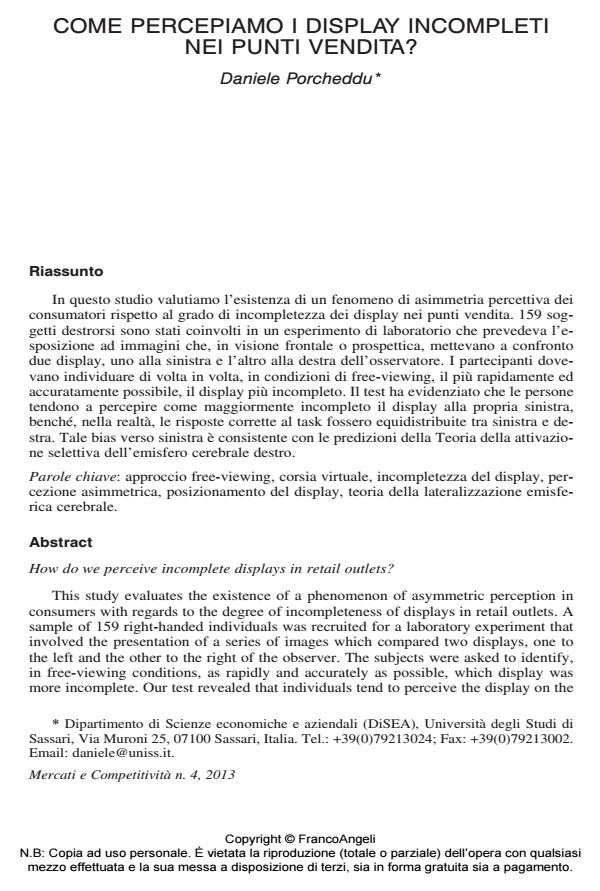Come percepiamo i display incompleti nei punti vendita?
Titolo Rivista MERCATI E COMPETITIVITÀ
Autori/Curatori Daniele Porcheddu
Anno di pubblicazione 2013 Fascicolo 2013/4
Lingua Italiano Numero pagine 23 P. 59-81 Dimensione file 973 KB
DOI 10.3280/MC2013-004004
Il DOI è il codice a barre della proprietà intellettuale: per saperne di più
clicca qui
Qui sotto puoi vedere in anteprima la prima pagina di questo articolo.
Se questo articolo ti interessa, lo puoi acquistare (e scaricare in formato pdf) seguendo le facili indicazioni per acquistare il download credit. Acquista Download Credits per scaricare questo Articolo in formato PDF

FrancoAngeli è membro della Publishers International Linking Association, Inc (PILA)associazione indipendente e non profit per facilitare (attraverso i servizi tecnologici implementati da CrossRef.org) l’accesso degli studiosi ai contenuti digitali nelle pubblicazioni professionali e scientifiche
In questo studio valutiamo l’esistenza di un fenomeno di asimmetria percettiva dei consumatori rispetto al grado di incompletezza dei display nei punti vendita. 159 soggetti destrorsi sono stati coinvolti in un esperimento di laboratorio che prevedeva l’esposizione ad immagini che, in visione frontale o prospettica, mettevano a confronto due display, uno alla sinistra e l’altro alla destra dell’osservatore. I partecipanti dovevano individuare di volta in volta, in condizioni di free-viewing, il più rapidamente ed accuratamente possibile, il display più incompleto. Il test ha evidenziato che le persone tendono a percepire come maggiormente incompleto il display alla propria sinistra, benché, nella realtà, le risposte corrette al task fossero equidistribuite tra sinistra e destra. Tale bias verso sinistra è consistente con le predizioni della Teoria della attivazione selettiva dell’emisfero cerebrale destro.
Parole chiave:Approccio free-viewing, corsia virtuale, incompletezza del display, percezione asimmetrica, posizionamento del display, teoria della lateralizzazione emisferica cerebrale.
Jel codes:M31
- Converting Shelf-Based Scarcity into Innovation by Adopting Customer-Focused Innovation Approach Antonio Usai, Daniele Porcheddu, Veronica Scuotto, Jean-Paul Susini, in Journal of the Knowledge Economy /2020 pp.70
DOI: 10.1007/s13132-018-0536-y
Daniele Porcheddu, Come percepiamo i display incompleti nei punti vendita? in "MERCATI E COMPETITIVITÀ" 4/2013, pp 59-81, DOI: 10.3280/MC2013-004004